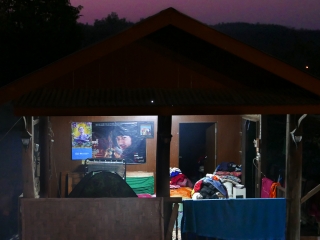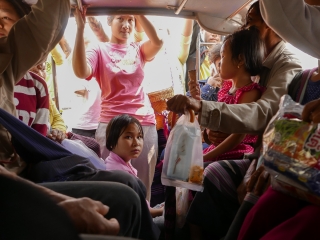I can’t exactly point out the moment when I was taken with Mae Sot, a small boomtown on the border of Thailand and Burma. Maybe it was on the evening on my arrival, after traveling on an empty yet remarkably modern highway in the mountains and stumbling upon parking lots filled with music and joyful people. Or maybe the next morning, when I rode my bike the wrong way for kilometers on a busy street, and instead of hearing “You farang, learn to drive!” I was greeted with hellos and smiles from children going to school and their parents. Or shortly after, when I visited the local market, one of the most ethnically, botanically, zoologically rich (and even stomach-turning) that I had seen thus far.


Mae Sot is a city people usually come to leave from. Either to cross into Burma, or, as I’ve witnessed, to label it as uninteresting and seek the first bus out after just a few hours. Some twenty years ago, Lonely Planet painted the picture of a wild west town whose inhabitants still wore (and used) guns, ten years ago Mae Sot was rebranded as a boring place to be unless you were working in one of the local NGOs, while the current description is a vivid and convincing enumeration of all the ethnicities, languages, and attire that make up the cityscape. For good reason.
The constant influx of refugees from Burma (Mon, Karen, Shan and other minorities), the city’s position on major trade routes, its good environment for Thai, Chinese, and Muslim businesses alike, a growing expat community of NGO workers, the coexistence of several religions and of more than a handful of food cultures guarantee that there is always something to see, hear or smell in Mae Sot’s streets. For me, the lack of established sights, the unpretentiousness and the effervescent daily rhythm made Mae Sot the perfect terrain to Become a Bluff Local in 7 Days, i.e. embark on an intense program of exploration and activities, at the end of which I can (and have the necessary knowledge to) pretend that I live in that particular town and have my usual spots.

On the first days, I soaked up the atmosphere of the city and laid down some highlights for orientation on my blank map. Mae Sot has a central market, several temples and a mosque, and they were a good place to begin observing local life. After this pilgrimage, I ventured to the town’s outskirts to see the border market, a cornucopia of products from both countries, but also of migrants stuck in the area, waiting for visas. One side of the street was lined with heavy teak furniture, Buddha statues and all things plastic, the other with immigration and employment agencies where Burmese men and women had been queuing, by the looks of it, for days.


Crossing the bridge into Burma would have invalidated my Thai visa, so I biked in the border area, getting lost in a labyrinth of shacks and poverty, with extremely welcoming people.

Then back in Mae Sot, it was time for more side roads and spontaneous exploring, at various moments of the day, which connected the big dots on my map and helped me add new ones to it, like: the Chinese shop with a bench in front where I could sit down and have breakfast, the bridge where a man sat all day hoping to catch fish with a homemade speargun, the wooden house where a lady ironed shirts while watching TV every evening, the food stall where they let me play with their daughter.


Day after day, I dug through the town’s layers, until it felt less and less foreign, and I could anticipate the sights on a particular street at a particular hour. I carried on with my program and made the acquaintance of some locals: two schoolgirls who took me on a trip out of town to a temple in their village, and a Burmese student who showed me the local market through her eyes. Toward the end of the week, I was ready and at ease with spending an afternoon of pure local living: I went to the hairdresser’s, did my laundry at the local laundromat, chatted with a neighbor about her dog, bought vegetables at the market and cooked a Burmese dish. My training was almost complete, with one exception: you can’t truly become a bluff local if you don’t impart, with great self-assurance, your knowledge of the city on others.



On my first days in Mae Sot, I was getting sporadic questions from other farangs, mainly about the mosque, so I learned to point the route to it from just about anywhere. But the stakes rose thanks to B., a restless French in his late 40s, traveler for half of the year, inhabitant of a van at the Spanish border for the rest. B. too was in Mae Sot in order to leave it. His plan was to travel to an enigmatic monastery in Burma and do meditation for a very frugal month. Only that his ‘leaving’ took about a week, which gave us several occasions to meet randomly in the streets and clear any of B.’s disorientations. One day before my departure, B. needed my Mae Sot expertise for an important mission: he wanted to buy cotton T-shirts for his meditation retreat. I suggested the Saturday night market (an unmissable experience for anyone wishing to pretend local). But the merchandise turned out to be too flashy and we ended up wondering how Hello Kitty would get along with Buddha at an open air restaurant with live Thai pop.


A comedy of a conversation followed for the next two hours. B. told me he conceived and sold single-seat aircrafts for a living; anyone could buy a kit with the instructions from his website and build their very own functional airplane, so I was incredibly curious to learn more. But B. was in Saturday night mode, trying to have fun and to flirt by overwhelming me with jokes and teasing remarks. I asked something about airplanes, he replied something about my eyes. His downpour of humor left me completely disarmed, although I keep a good stack myself for such occasions. From our table we could see the heart of the night market and, by the time B. was finally tracing the obscure history of single-seat aircrafts for me, the crowd had dispersed, so the sellers packed and left, the lights went out and not a soul was in sight.
At that point we decided to head back and strolled down the empty streets where the market had been. The parking lot looked desolate too. At first I was amazed at the radical change of the place, from bustling to dead silent, but suddenly I remembered I had parked my bike there. “Your bike was stolen,” B. verbalized my thoughts, adopting a very serious stance all of a sudden. The realization completely destroyed the aura of the evening, especially that the guesthouse owner had lent me the bike—a new one—simply because she wanted me to have a good time in Mae Sot. B. assumed that the bike was already in Burma, while I, after my many days in town, was willing to place my bet on the honesty of Mae Sot’s inhabitants. I circled the entire area for some clues, but everything was closed, doors pulled down, no movement in the streets. B. noticed a surveillance camera very close to where my bike had been parked and persuaded the owners, with very apt sign language, to show us the footage the next morning. While he walked me to my guesthouse, we debated the morality of that part of the world, a conversation which made the bike oscillate, like Schrödinger’s cat, between two opposite simultaneous states: forever gone in B.’s cynical outlook, sheltered nearby in my more naïve one.
After a night of inquietude, I returned to the crime scene for the promised footage, only to find my bike parked exactly where I had left it, with the food I had bought from the night market still in the basket. After asking around, I found out that the owner of a shop, an old lady who spoke no English, had taken it in when the night market closed, assuming whoever owned the bike had forgotten it in the parking lot, an unsafe place during the night. I felt ashamed that the only words I knew in Thai to express my gratitude were “thank you very much.” That lady deserved more of a “you made my day and may all your kindness return to you tenfold.”
I tracked down B.’s hotel, a dusty baroque building that only the taxi drivers knew about, and we went for breakfast. Despite the evidence, B. was still clinging to his suspicious hypotheses and claimed I had been the target of a failed conspiracy (locals stealing tourist bikes to sell them or ask for a ransom). But I steered our conversation to his airplanes and secretly reveled in my glory as a bluff local (and in the taste of my chickpea roti).
My bike misadventure was taken very lightly by the guesthouse owner, a young mother quite inhibited by her limited English, who nevertheless seemed to understand and know everything. In the tourist folklore, stories about stolen/lost bikes abound and justice is always on the side of the Thai owner. I was preparing for a scenario in which I would have to pay the full price of the bike, but the owner, upon hearing the news, invited me first to see her dog’s newborn puppies and then smilingly offered me another bike, just as shiny and new, in case I wanted to go look for the lost one. When I brought the supposedly lost bike back, she seemed more relieved that I could go on vacationing without worries. And when I had to leave Mae Sot, since we couldn’t find a motorcycle taxi, she jumped on her own motorbike and gave me a free lift to the bus station. As I said goodbye to her, trying to convey how grateful I was for all her help and hospitality, the woman gently shushed me and put her hand on her heart. “If you happy, I happy.”
Yes, I was happy there, Mae Sot.






Leave a Reply